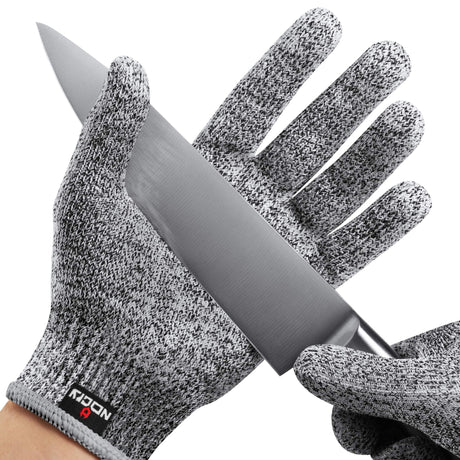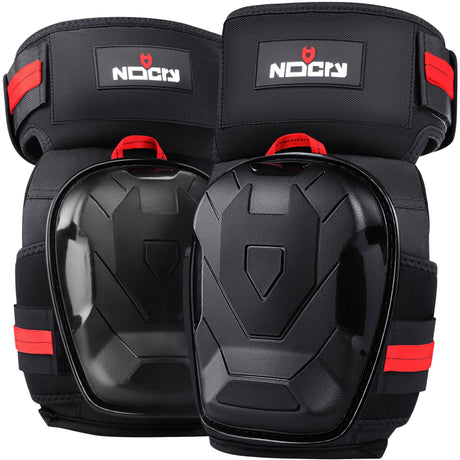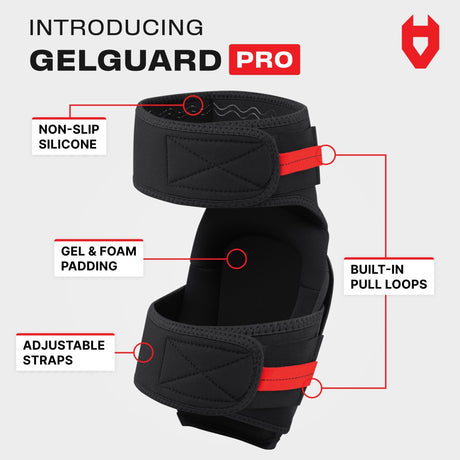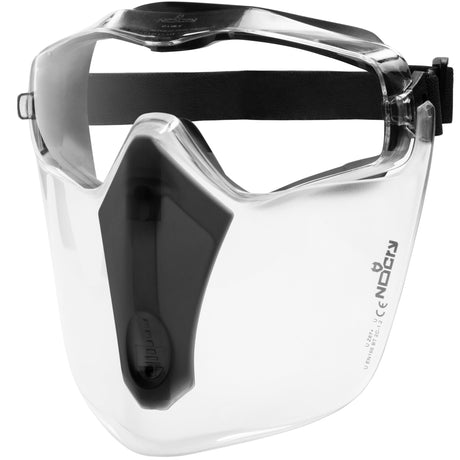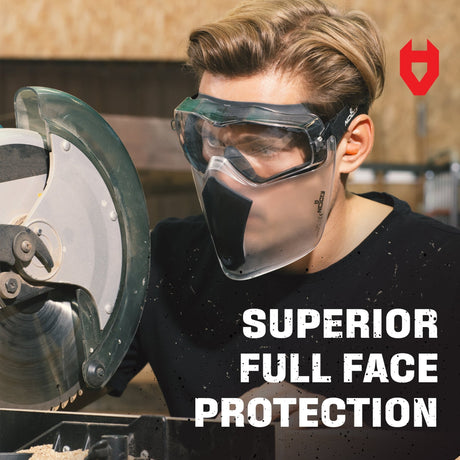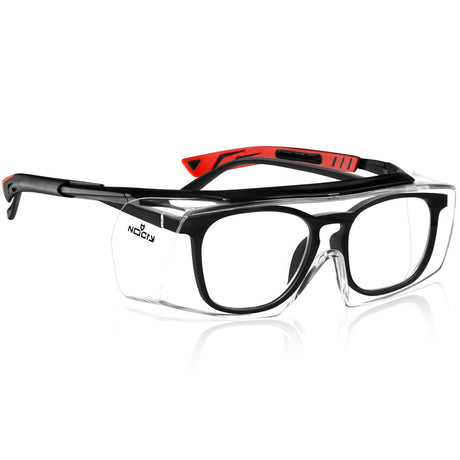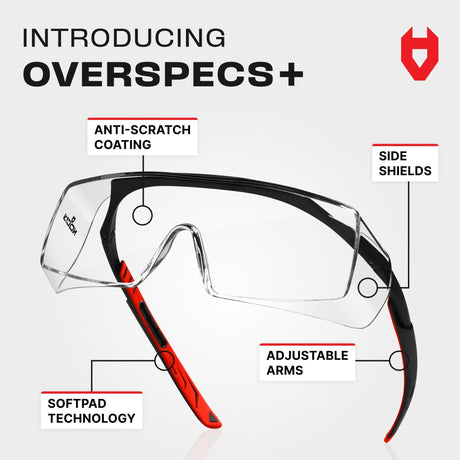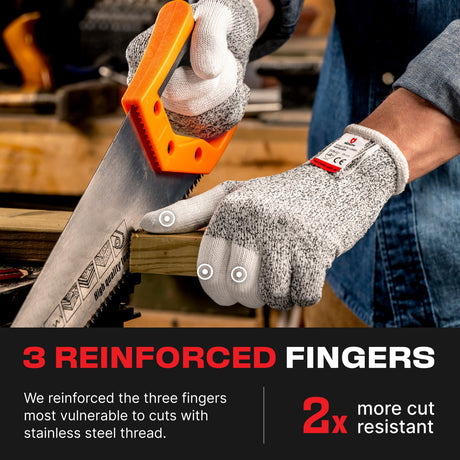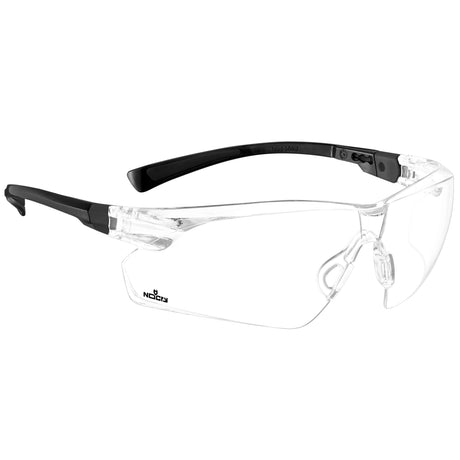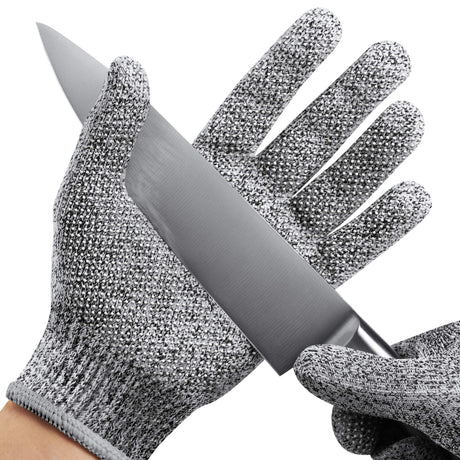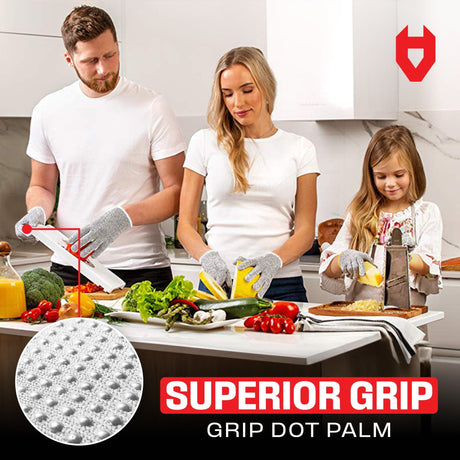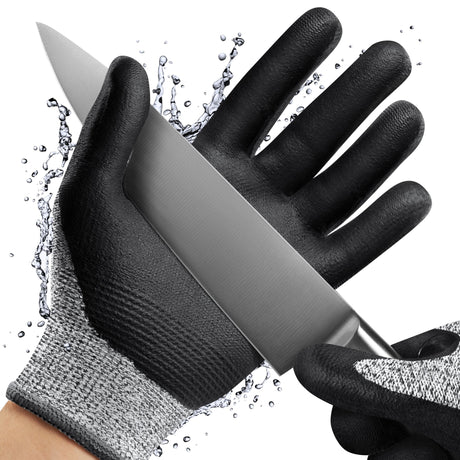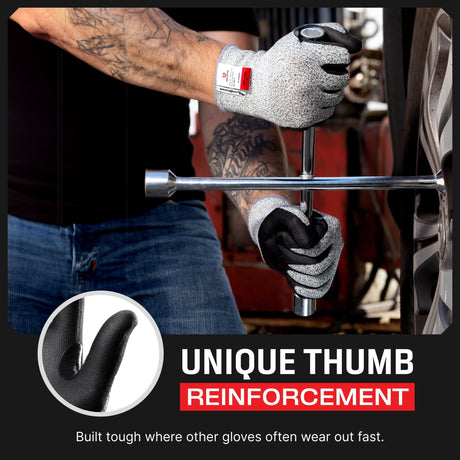Key Takeaways
- Cut-resistant gloves are made with engineered fibers like Kevlar, Dyneema, or steel mesh, which help slow or stop a blade’s movement.
- Cut, puncture, and abrasion resistance are different — a glove that resists one hazard may not protect against the others.
- No glove is cut-proof, but the right glove drastically lowers your risk when chosen based on your task.
- Testing standards like ANSI/ISEA 105 rate gloves from A1 to A9 for cut resistance — higher levels mean better protection.
- Wearing the wrong glove can create a false sense of security, especially in construction, food prep, or metalwork.
What are cut-resistant gloves made of?
Cut-resistant gloves are made from high-strength fibers and composites engineered to either absorb or deflect the energy of a sharp object. The key is how these materials interact with a moving blade — slowing it down, spreading the force, or resisting penetration.
Here’s a closer look at the most common materials:
- Kevlar: A para-aramid synthetic fiber known for its heat resistance and tensile strength. It’s tightly woven to create a tough barrier, making it ideal for both cut and heat protection. Kevlar remains flexible while resisting degradation from oils and chemicals.
- Dyneema: An ultra-high molecular weight polyethylene (UHMWPE) that’s incredibly lightweight yet stronger than steel by weight. Its smooth texture also makes it highly resistant to abrasion and ideal for food handling or fine assembly tasks.
- HPPE (High-Performance Polyethylene): Similar to Dyneema but used in a wide range of glove blends. It offers a good balance between cut, abrasion, and tear resistance and is often used in mid-range cut protection levels.
- Steel and fiberglass fibers: These are microfilaments woven into the glove’s fabric to add rigidity and sharp-edge protection. They’re rarely used alone—instead, they’re blended with softer yarns (like nylon or HPPE) to improve both comfort and safety.
- Stainless steel thread: Sometimes used in gloves to increase cut resistance and durability, stainless steel threads add extra sharp-edge protection without greatly affecting flexibility.
- Spandex : A stretchy synthetic fiber often blended with other materials to improve glove fit and flexibility, helping maintain dexterity while providing protection.
- Latex coatings: Some cut-resistant gloves use latex coatings on the palm and fingers to enhance grip and provide extra abrasion resistance. Latex is flexible and durable, but may not suit users with latex allergies.
Modern gloves often layer or blend these materials to target specific hazards, like combining steel fibers for cuts, Kevlar for heat, and spandex for stretch. The result is a glove that feels like fabric but performs like armor.
These materials don’t stop a blade like armor would — they delay or slow its penetration, giving your reflexes time to move your hand or avoid deeper injury.
Do cut-resistant gloves actually work?
Yes, cut-resistant gloves work, but only when used correctly and within their limits. The term “cut resistant” is often misunderstood. These gloves aren’t cut-proof — they’re designed to delay or reduce the severity of a cut by resisting the force and motion of a blade. That delay can make all the difference between a minor scrape and a deep laceration.
When people ask, “do cut-resistant gloves work?”, the answer depends on several key factors:
- The glove’s ANSI cut level: An A2 glove won’t protect you in a heavy metal fabrication shop. An A9 glove is far stronger but might be overkill for general food prep.
- The type of blade or hazard: Serrated edges, fast-moving blades, or pointed objects can behave differently. Cut resistance doesn’t mean puncture or stab resistance.
- The glove’s condition: Even the best glove loses its effectiveness if worn, frayed, or contaminated with oils or solvents that weaken the fibers.
Gloves can fail if:
- You’re wearing the wrong level of protection for your task.
- You’re relying on them for hazards they weren’t designed for (e.g., punctures or high heat).
- They’re damaged, misused, or past their service life.
Bottom line: Cut-resistant gloves are effective, but only when matched to the task and kept in good condition. Think of them as your last defense, not a reason to take risks.
What’s the difference between cut, puncture, and abrasion resistance?
It’s common to assume that a glove rated for one type of protection covers all hazards, but that’s not true. Cut, puncture, and abrasion resistance are three distinct types of protection, each addressing a specific risk. Gloves are tested and rated separately for each by ANSI/ISEA 105 standards.
Here’s how they differ:
- Cut Resistance: Designed to protect against slashing or slicing from sharp edges like knives, box cutters, or sheet metal. This involves a gliding or sawing motion, where the blade contacts the surface of the glove over time.
- Puncture Resistance: Focuses on hazards from pointed or piercing objects like nails, needles, or wire. This is a direct, concentrated force — think of it as a stabbing motion. Many cut-resistant gloves score low in this category if they lack reinforcement.
- Abrasion Resistance: Measures how well a glove can withstand friction or repeated rubbing against rough surfaces like concrete, rope, or wood. Gloves with high abrasion resistance are built to last longer under tough physical wear.
Important note: A glove that resists one hazard may fail against another. For example, a glove made with high-strength fibers like Kevlar may stop a slicing blade but won’t necessarily protect against a nail puncture or concrete scraping. That’s why it’s critical to check each glove’s individual ratings and choose based on the specific hazards of your task.
Understanding these differences helps you avoid a false sense of security and ensures you’re protected from all angles, not just the obvious ones.
How are gloves rated for cut resistance?
In North America, cut resistance is measured using the ANSI/ISEA 105 standard, which rates gloves based on the amount of cutting force (in grams) required to penetrate the glove’s surface using a standardized straight-edge blade.
Gloves are categorized into nine levels, from A1 to A9. This rating system helps workers match the glove to the real-world hazards they face. For example, a food service worker slicing vegetables needs flexibility and A2-level protection, while someone cutting automotive parts might need an A6 or higher.
Using a glove below the required level can create a dangerous false sense of security, especially if the glove looks tough but isn’t built for the specific task. Always review the ANSI rating on the glove or its packaging before use.
For reference, the ANSI cut level is usually printed on the glove or included in product specs. It’s your first clue whether a glove is up to the task, or not.

What are cut-resistant gloves used for?
Cut-resistant gloves are essential in jobs where hands are exposed to sharp tools, edges, or materials. They help reduce the risk of lacerations, especially during tasks that involve repetitive motion, speed, or force.
They’re used across a wide range of industries, including:
- Construction: For tasks like cutting drywall, tying rebar, handling sheet metal, or using utility knives. Workers often encounter jagged edges and sharp tools, so medium to high cut protection is typically needed.
- Food processing & kitchens: Workers slicing meat, fish, or produce use lighter gloves (usually A2–A3) that balance cut protection with dexterity and hygiene. Look for gloves rated for food contact and easy cleaning.
- Automotive & manufacturing: Technicians and assembly line workers often handle stamped metal, sharp plastic parts, or unfinished glass. Gloves here often range from A4 to A7, offering strong protection without limiting hand movement.
- HVAC, plumbing & electrical work: Professionals in these trades frequently reach into tight spaces with sharp metal edges, nails, or jagged piping. Gloves must provide cut resistance along with flexibility and sometimes grip or insulation.
Some industries also require gloves that combine cut protection with other features, such as heat resistance, chemical protection, or touchscreen compatibility. Choosing the right glove depends not just on the task, but also on the level of risk and the need for precision.
Always match glove ratings to the job —wearing a glove that’s too light (or too bulky) for the work can be just as dangerous as wearing none at all.
Common myths about cut-resistant gloves
There’s a lot of confusion out there when it comes to cut-resistant gloves, and that confusion can lead to injury. Let’s break down a few of the biggest myths:
Myth: All cut-resistant gloves are the same.
Truth: Not even close. Gloves are rated from A1 to A9 based on how much force they can withstand before being cut. A glove made for food slicing (A2) won’t protect you in construction or metalworking (which might need A6 or higher). Always check the ANSI rating and match it to the job.
Myth: They protect against all sharp things.
Truth: Cut resistance is not the same as puncture resistance. A glove that stops a slicing motion may still fail against a sharp nail, needle, or wire. It’s important to understand the type of hazard you’re working with (cut, puncture, or abrasion) and choose accordingly.
Myth: You only need gloves for high-risk jobs.
Truth: Even low-risk jobs like opening boxes or slicing vegetables can cause painful injuries. Many hand injuries happen during “quick tasks” when people assume they’re safe without gloves. A lightweight glove with a lower cut rating can still make a big difference in everyday work.
Myth: Once rated, a glove always works.
Truth: Like any gear, gloves wear out over time. Exposure to moisture, oils, UV light, or heavy use can degrade the fibers and weaken protection. Regular inspections are critical; if you see fraying, thinning, or holes, it’s time to replace them.
Conclusion
If you’re wondering whether cut-resistant gloves even work, the answer is yes, when used correctly. They can prevent serious injuries, but only if:
- You choose the right material and cut level.
- You understand what they don’t protect against.
- You replace worn-out gloves regularly.
Cut-resistant gloves are not magic. But with the right fit and proper use, they can be one of the most effective pieces of workplace safety gear available.
FAQ
Do cut-resistant gloves make you completely cut-proof?
No, they reduce the risk and severity of cuts but don’t make your hands invincible. They buy you time to react.
How do I know what cut resistance level I need?
Match the glove’s ANSI/ISEA cut level to your task’s hazards. Light tasks need A1–A3, medium tasks A4–A6, and heavy-duty work A7–A9.
Can cut-resistant gloves protect against punctures?
Not always. Puncture resistance is tested separately. Look for gloves rated for puncture protection if that’s a risk.
How long do cut-resistant gloves last?
It depends on use and care. Inspect gloves regularly for wear, thinning, or damage and replace them as needed.
Are all cut-resistant gloves food-safe?
No. Only gloves labeled for food handling meet hygiene and safety standards for food prep.
Can I use cut-resistant gloves for heat protection?
Not unless specifically rated for heat. Cut resistance and heat resistance are different properties.







